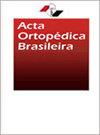柔术黑带运动员肩部功能评估。
IF 0.5
4区 医学
Q4 ORTHOPEDICS
Acta Ortopedica Brasileira
Pub Date : 2023-10-23
eCollection Date: 2023-01-01
DOI:10.1590/1413-785220233105e264796
引用次数: 0
摘要
目的:评估柔术黑带运动员的流行病学特征,包括疼痛和肩部功能的患病率。方法:对2014年至2016年的柔术运动员进行横断面研究。研究的变量包括:性别、年龄、主肢、体重、身高、职业、柔术练习时间、每周训练时间、其他练习的运动、合并症、受伤和以前的手术、药物和习惯。肩部功能评估采用ASES评分。结果:对53名男运动员进行了评定。饮酒(60.4%)和服用补充剂(32.1%)的患病率较高。其他运动包括重量训练(49.1%)和其他武术(17%)。膝关节(66.0%)和肩部(52.8%)受伤的发生率较高,在某些情况下,需要进行手术。肩部疼痛普遍存在(73.6%),超过一半的运动员(52.9%)肩部功能有轻微或中度限制。结论:柔术黑带运动员经常有受伤史,肩部是受影响第二大的身体部位。根据ASES评分,超过一半的运动员普遍存在肩部疼痛和功能受限。证据水平III,回顾性比较研究。本文章由计算机程序翻译,如有差异,请以英文原文为准。

FUNCTIONAL ASSESSMENT OF THE SHOULDER IN JIU-JITSU BLACK BELT ATHLETES.
ABSTRACT Objective: To assess the epidemiological profile of Jiu-Jitsu black belt athletes, including the prevalence of pain and shoulder function. Methods: Cross-sectional study carried out with Jiu-Jitsu athletes from 2014 to 2016. The studied variables were: sex, age, dominant limb, weight, height, profession, time of Jiu-Jitsu practice, weekly training hours, other practiced sports, comorbidities, injuries and previous surgeries, medications and habits. For the functional assessment of the shoulder, the ASES Score was used. Results: 53 male athletes were evaluated. There was a prevalence of alcohol consumption (60.4%) and supplement use (32.1%). The practice of other sports included weight training (49.1%) and other martial arts (17%). There was a prevalence of knee (66.0%) and shoulder (52.8%) injuries and, in some cases, the need for surgical procedures. There was a prevalence of shoulder pain (73.6%) and more than half of the athletes (52.9%) had minimal or moderate limitation of shoulder function. Conclusion: Jiu-jitsu black belt athletes often have a history of injuries, with the shoulder being the second most affected body part. In more than half of the athletes, there was a prevalence of shoulder pain and functional limitation, according to the ASES Score. Level of evidence III, Retrospective comparative study.
求助全文
通过发布文献求助,成功后即可免费获取论文全文。
去求助
来源期刊

Acta Ortopedica Brasileira
Orthopedics-
CiteScore
0.90
自引率
14.30%
发文量
67
审稿时长
25 weeks
期刊介绍:
A Revista Acta Ortopédica Brasileira, órgão oficial do Departamento de Ortopedia e Traumatologia da Faculdade de Medicina da Universidade de São Paulo (DOT/FMUSP), é publicada bimestralmente em seis edições ao ano (jan/fev, mar/abr, maio/jun, jul/ago, set/out e nov/dez) com versão em inglês disponível nos principais indexadores nacionais e internacionais e instituições de ensino do Brasil. Sendo hoje reconhecidamente uma importante contribuição para os especialistas da área com sua seriedade e árduo trabalho para as indexações já conquistadas.
 求助内容:
求助内容: 应助结果提醒方式:
应助结果提醒方式:


